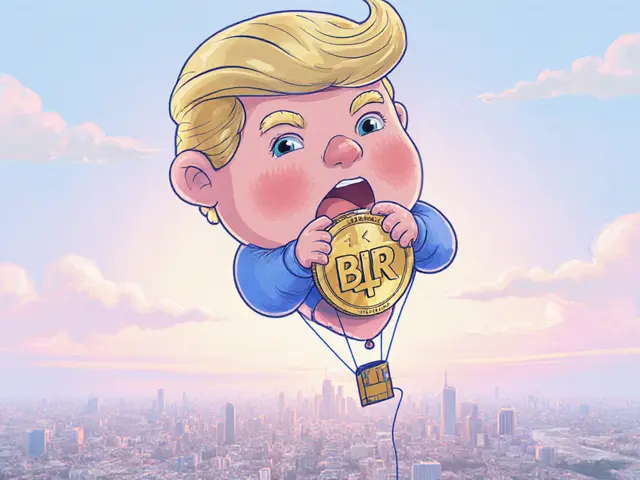Understanding Qatar's Institutional Crypto Ban and Its Impact on the Financial Sector

Qatar Crypto Regulation Compliance Checker
Qatar's cryptocurrency ban is governed by:
- QCB Circular No. 6 (2018): Prohibits all licensed banks from facilitating cryptocurrency transactions
- QFCRA Virtual Asset Alert (2019): Extends prohibition to Qatar Financial Centre
- QFC Digital Assets Regulations (2024): Allows tokenization of traditional assets only
All activities involving 'Excluded Tokens' are strictly prohibited.
Enter your details and click "Check Compliance Status"
Key Compliance Points:
- Non-compliance leads to license revocation
- Penalties can reach 5% of annual revenue
- Tokenized securities are allowed with approval
- Individuals can hold crypto but cannot trade through banks
Qatar cryptocurrency ban is the collection of rules that forbid banks, investment firms and other licensed financial institutions in Qatar from dealing with cryptocurrencies, stablecoins or any digital token that functions as a currency substitute. Since the Qatar Central Bank (QCB) first issued Circular No.6 in February2018, the country has tightened the no‑no on crypto across the entire financial sector. The ban sits alongside a newer, tightly‑controlled framework for tokenized traditional assets, leaving the door open for blockchain‑based securities while keeping bitcoin‑style coins firmly out.
Key Takeaways
- QCB Circular No.6 (2018) and the QFCRA’s 2019 Virtual Asset Alert together create a blanket prohibition on crypto‑related services for all Qatar‑licensed financial institutions.
- The ban covers cryptocurrencies, stablecoins, CBDCs and any token classified as an “Excluded Token”.
- QFC Digital Assets Regulations (effective 1Sept2024) allow tokenization of shares, bonds, sukuk, commodities and real estate, but explicitly keep the crypto ban in place.
- Non‑compliance can lead to licence revocation, heavy fines and reputational damage.
- Regional peers such as the UAE and Bahrain are far more permissive, while Kuwait mirrors Qatar’s strict stance.
How the Ban Was Built - Timeline of Major Moves
- Feb2018 - QCB Circular No.6: Prohibited all licensed banks from facilitating bitcoin transactions or any service that could be deemed a cryptocurrency activity.
- Dec262019 - QFCRA Virtual Asset Alert: Extended the prohibition to the Qatar Financial Centre, banning exchange, custody, transfer and issuance services for virtual assets.
- Sep12024 - QFC Digital Assets Regulations: Introduced a sandbox for tokenized securities while reaffirming that crypto‑type tokens remain “Excluded Tokens”.
- 2025 - Ongoing enforcement: QCB conducts regular compliance audits; penalties include licence suspension and monetary fines.
What Exactly Is Prohibited?
The 2019 QFCRA alert lists four core activities that institutions cannot perform:
- Exchanging virtual assets for fiat currency.
- Transferring, safekeeping or custodial services for virtual assets.
- Providing any advisory or brokerage service linked to a virtual‑asset issuance.
- Offering investment products that involve crypto‑based returns.
All three token categories - traditional cryptocurrencies (e.g., Bitcoin, Ethereum), stablecoins (e.g., USDT, BUSD) and central bank digital currencies (CBDCs) - fall under the “Excluded Tokens” label.
Why Qatar Chose the Hard Line
Two strategic pillars drive the policy:
- Qatar National Vision 2030 emphasizes economic diversification without jeopardising monetary sovereignty.
- The Third Financial Sector Strategic Plan calls for a stable, well‑regulated banking environment that can attract global institutional capital.
By keeping cryptocurrencies out of the regulated arena, Qatar avoids the volatility, money‑laundering risks and regulatory uncertainty that many emerging markets still grapple with.
Controlled Innovation: The QFC Digital Assets Framework
Even with a total crypto ban, Qatar isn’t shutting out blockchain entirely. The QFC Digital Assets Regulations (2024) create a sandbox for “approved tokens”. These are tokenized representations of traditional assets such as:
- Shares of publicly listed Qatari companies.
- Corporate bonds and sukuk.
- Commodities like oil‑linked certificates.
- Real‑estate parcels tokenized for fractional ownership.
To qualify, a token must be registered, validated by the QFCRA and stored in a regulated custody solution. The framework deliberately excludes any token that functions as a currency substitute, preserving the core ban.

Enforcement - How Compliance Is Policed
Financial institutions inside Qatar must embed the ban into their compliance programs. Key mechanisms include:
- Regular reporting: Quarterly filings to QCB that detail any crypto‑related activity (which should be zero).
- Audits: On‑site inspections by QFCRA compliance officers.
- Sanctions: Immediate licence suspension for violations, followed by fines that can exceed 5% of annual revenue.
International banks operating in multiple GCC jurisdictions typically run separate legal entities for Qatar to keep crypto services out of the local operation.
Regional Comparison - Where Qatar Stands in the GCC
| Country | Regulatory Approach | Key Legislation | Allowed Activities |
|---|---|---|---|
| Qatar | Prohibitive | QCB Circular6 (2018), QFCRA Virtual Asset Alert (2019) | Tokenized securities only |
| Kuwait | Prohibitive | Kuwait Central Bank directives (2023‑2024) | None - full ban |
| United Arab Emirates | Permissive | DFSA Crypto Framework (2020), ADGM Virtual Asset Regulations (2021) | Trading, custody, token issuance |
| Bahrain | Progressive | Bahrain Central Bank Virtual Asset Rules (2022) | Trading, custodial services, DeFi pilots |
| Saudi Arabia | Mixed | Saudi Central Bank CBDC Project (2023) | Wholesale CBDC for interbank settlement; retail crypto limited |
Practical Implications for International Firms
If you run a cross‑border asset manager, the Qatar ban means you must carve out a crypto‑free business line for any entity licensed in Doha. Typical steps include:
- Set up a dedicated legal entity for Qatar that excludes all crypto product codes from its service catalogue.
- Update AML/KYC procedures to flag any client request for crypto exposure and automatically route it to a non‑Qatari unit.
- Train compliance staff on the specifics of QCB Circular6 and QFCRA Alert language.
- Conduct a quarterly self‑audit and submit the required compliance report to QCB.
Failing to isolate crypto operations can trigger severe penalties, including the loss of your banking licence in Qatar.
Future Outlook - Will the Ban Ever Loosen?
Experts agree that the core prohibition is unlikely to disappear in the near term. The reasons are simple:
- Qatar’s policy is tightly linked to its sovereign monetary strategy.
- Regional peers that have embraced crypto (UAE, Bahrain) are still monitoring systemic risks.
- Domestic demand for retail crypto services remains low compared with the desire for tokenized traditional assets.
That said, the QFC Digital Assets Regulations are slated for a second‑quarter‑2025 update, which could broaden the list of approved tokenized assets. If neighboring jurisdictions demonstrate that regulated crypto markets can coexist with financial stability, Qatar may consider a narrowly‑targeted sandbox for institutional crypto‑derivatives - but only after extensive risk‑assessment.
Key Takeaways for Stakeholders
Whether you’re a compliance officer, a fintech entrepreneur, or an investor eyeing the Gulf, remember these three points:
- Zero tolerance: Any crypto‑related activity inside a Qatar‑licensed entity is a direct breach.
- Tokenized securities are safe: The QFC framework lets you issue blockchain‑backed shares, bonds or real‑estate tokens, provided they are registered and stored in approved custodians.
- Plan for separate operations: International firms must maintain distinct, crypto‑free branches for Qatar to stay compliant.
In short, the Qatar cryptocurrency ban remains a firm wall around the traditional financial sector, while a narrow, controlled gate opens for blockchain‑based tokenization of real assets. Understanding the fine line between prohibition and permission is essential for anyone doing business in the region.
Frequently Asked Questions
Is it illegal for an individual in Qatar to own Bitcoin?
The ban targets licensed financial institutions, not private citizens. Individuals can hold crypto in personal wallets, but no bank or broker can facilitate a purchase, sale or custody for them.
Can a Qatar‑based bank offer tokenized sukuk under the new regulations?
Yes, if the sukuk token is registered with the QFCRA, meets the validation criteria, and is stored in an approved custodial solution. The token must not act as a currency substitute.
What are the penalties for breaching QCB Circular6?
Violations can lead to licence suspension or revocation, fines up to 5% of the institution’s annual revenue, and potential criminal charges for senior officers if negligence is proved.
How does Qatar’s crypto ban compare to the UAE’s framework?
The UAE permits licensed firms to offer crypto trading, custody, and token issuance under the DFSA and ADGM rules. Qatar, by contrast, bans all institutional crypto activity but allows tokenized securities, making its approach far more restrictive.
Will the ban affect foreign investors who hold crypto through offshore accounts?
Foreign investors can keep offshore crypto holdings, but any Qatar‑registered entity they work with cannot facilitate transactions involving those assets. Attempting to route crypto through a Qatari bank would breach the ban.







Navigating Qatar's regulatory tapestry feels like walking through a maze of buzzwords and red tape. The QCB Circular No.6 essentially creates a hard ceiling on any crypto‑related service, which forces banks to re‑engineer their AML pipelines. Meanwhile, the QFCRA alert of 2019 doubles down, effectively branding every 'excluded token' as a no‑go zone. From a compliance officer’s perspective, you end up juggling KYC, transaction monitoring, and a never‑ending list of exception reports. The new QFC Digital Assets Regulations try to sprinkle some blockchain optimism, but only for tokenized securities that have been blessed by the regulator. In practice, this bifurcated regime drives a wedge between innovation and risk‑aversion. It's a classic case of regulatory arbitrage where the only safe bet is to stay out of the crypto game. Bottom line: institutions must build a parallel compliance silo just to keep the watchdog at bay.
One might argue that the very act of drawing a regulatory line reveals a deeper existential tension between state sovereignty and decentralized autonomy. When Qatar declares crypto a forbidden fruit, it inadvertently casts a spotlight on the moral calculus of financial freedom. The paradox lies in allowing tokenized assets while vilifying the underlying digital currencies that could democratize capital. Such a selective embrace resembles an ethical double‑standard, where the state permits what it can control and bans what it cannot. In the grand schema of monetary philosophy, this is less about risk mitigation and more about preserving a narrative of centralized legitimacy.
Hey folks, great rundown! If you’re a compliance wizard, just remember to flag any crypto‑related activity in your core systems right away. A quick audit checklist can save you a lot of sleepless nights later. Keep the tokenized securities pipeline clean and you’ll stay in the green. 🚀
When I first glanced at Qatar’s institutional crypto ban, I was struck by the sheer theatricality of the policy language-terms like “excluded token” and “prohibited activity” read like a legal opera. The QCB Circular No.6, issued back in 2018, set the stage by prohibiting any licensed bank from facilitating Bitcoin transactions, effectively placing a velvet rope around the crypto party. Two years later, the QFCRA Virtual Asset Alert of 2019 widened the curtain, extending the prohibition to the Qatar Financial Centre and explicitly banning exchange, custody, transfer, and advisory services for virtual assets. This layered approach creates a regulatory tapestry that is as intricate as it is intimidating, forcing institutions to weave compliance threads into every corner of their operations. The 2024 QFC Digital Assets Regulations, however, introduce a sliver of light by permitting the tokenization of traditional assets, but only after a rigorous approval dance involving registration, validation, and custodial safeguards. In practical terms, this means banks can issue blockchain‑backed sukuk or oil‑linked certificates, yet they must keep the crypto beast firmly locked in a separate cage. The juxtaposition of a complete ban on currency‑like tokens alongside a sandbox for securities is a fascinating study in selective openness. It reflects Qatar’s broader strategic vision: diversify the economy without surrendering monetary sovereignty. For compliance officers, the reality is a dual‑track compliance framework-one track that says “never touch crypto” and another that says “you may mint tokenized bonds if you jump through these hoops.” The operational impact is profound: IT teams must build parallel processing pipelines, legal departments must draft bifurcated policies, and risk managers need to assess two distinct risk matrices. Moreover, the threat of license revocation and fines up to 5% of annual revenue looms like a storm cloud over any misstep. This punitive edge serves both as a deterrent and a reminder that the regulator’s patience is finite. Yet, there’s an undercurrent of optimism among fintech innovators who see the tokenized securities allowance as a foothold for broader blockchain adoption. They argue that once the institutionally‑approved token ecosystem gains traction, the rigid walls around crypto may erode gradually. In contrast, skeptics warn that the ban could push crypto activity underground, fostering illicit channels that evade oversight altogether. Ultimately, the future of Qatar’s crypto stance will hinge on how effectively the sandbox can demonstrate low‑risk innovation while the ban remains an ironclad shield against monetary volatility. As the GCC region evolves, Qatar’s model may either become a blueprint for controlled innovation or a cautionary tale of overregulation. Only time will tell whether the regulatory pendulum swings toward liberalization or stays firmly locked in its current position.
It is incumbent upon discerning financial entities to acknowledge the unequivocal imperatives emanating from Qatar’s legislative corpus. The prohibition articulated in Circular No.6, coupled with the QFCRA Alert, constitutes a categorical interdiction of any crypto‑centric endeavor. Such juridical rigor reflects a sovereign resolve to safeguard monetary stability against the vicissitudes of decentralized assets. While the QFC’s tokenization provisions ostensibly introduce a modicum of flexibility, they remain circumscribed by exacting procedural requisites. Accordingly, any institution aspiring to operative compliance must meticulously calibrate its operational architecture to preclude inadvertent transgressions. Failure to adhere to these doctrinal strictures invites severe punitive recourse.
Yo, the takeaway is simple: keep crypto out of your Doha branch and you’ll be fine. If you want to play with tokenized sukuk, get the green light and stick to the approved custodian. Just make sure your AML software isn’t flagging “crypto” by accident. It’s a pain, but the alternative is losing your license-no joke.
Quick tip for anyone setting up a Qatar unit:
1️⃣ Build a separate legal entity that has zero crypto product codes.
2️⃣ Train your front‑office staff to say “no” to any crypto request and route it offshore.
3️⃣ Keep detailed quarterly reports-QCB loves paperwork.
✅ Stay compliant and keep your CEO happy. 😎👍
From a compliance standpoint, the safest approach is to implement a binary flag in your transaction monitoring system that automatically rejects any transaction involving excluded tokens. This simple technical control can dramatically reduce the risk of inadvertent violations.
Looks like another regulatory overreach. 🤷♂️
The moral calculus in this scenario is unmistakable: a jurisdiction that enforces draconian bans while touting progressive tokenization is engaging in selective moralism. Institutions must not only obey the letter of the law but also interrogate the ethical implications of facilitating any gateway to decentralized finance. By refusing to compromise on integrity, we uphold the social contract that binds financial stability to public trust. Any deviation invites not just legal repercussions but also erodes the ethical foundation of the banking sector.
Enough with the half‑measures-Qatar’s outright ban on institutional crypto is a blunt instrument that screams “we don’t trust innovation.” If the goal is to protect the economy, a nuanced risk‑based framework would be far more effective than a blanket prohibition that only drives the activity underground. The current stance is counterproductive and harms the very investors the regulators claim to protect.
Don’t let the strict regulations dampen your entrepreneurial spirit. Use the tokenized securities sandbox to showcase how blockchain can add real value to traditional assets, and you’ll turn a constraint into a competitive advantage.
Listen up: when you architect your compliance stack, integrate a dedicated crypto‑exclusion module that cross‑references the QCB Circular taxonomy. This isn’t just best practice; it’s a non‑negotiable prerequisite to avoid the 5% revenue penalty. Deploy it now and you’ll safeguard your institution’s operational resilience.
In the grand theater of finance, Qatar’s policy is the stern director insisting that the actors stay in their assigned roles. The crypto “villain” is forced to lurk in the shadows, while tokenized securities take center stage as the noble protagonist. This dichotomy forces us to ponder whether true financial evolution can ever flourish under such scripted constraints, or if the audience will eventually demand a rewrite of the script.
For clarity, the compliance workflow should: 1) Identify any activity involving excluded tokens; 2) Trigger an automatic denial flag; 3) Log the event with timestamp and responsible officer; 4) Generate a quarterly compliance report for QCB submission. Executing these steps mitigates regulatory risk and ensures auditability. 😊
Keep crypto out of your Qatar entity stay compliant and avoid fines
This ban is a textbook example of regulatory fearmongering that stifles any meaningful progress in the financial sector.
Qatar’s firm stance showcases the pride of a nation determined to protect its monetary sovereignty against the chaotic influx of foreign crypto ideologies. By drawing a hard line, they preserve the integrity of their financial system while other Gulf states chase fleeting trends.
Interesting how Qatar limits crypto but still lets tokenized assets play out its own game you can see the balance they’re trying to hit
Imagine the blockchain as a tapestry-Qatar chooses to weave only the threads of traditional assets while casting the glittering crypto strands aside, fearing they might unravel the whole fabric. It’s a poetic, if cautious, dance between innovation and preservation.
Maybe they’re right to keep crypto out.
While Qatar’s ban may seem restrictive, it also opens a dialogue on how to safely integrate emerging tech without compromising financial stability. A balanced approach could benefit both regulators and innovators.